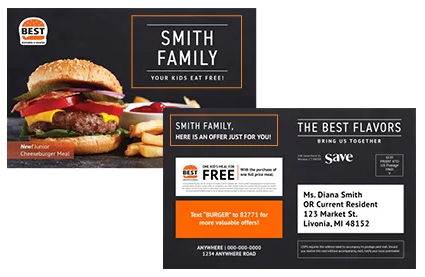The Postcard’s Evolution: Personalization Meets Affordability
3/29/2023 Megan OGorden

Marketers have long held an unfavorable view of postcards. They have tended to regard them as not only unsophisticated and impersonal, but also inefficient and not at all cost-effective.
The emergence of marketing technology, however, has significantly improved the personalization and targeting capabilities of postcards. Today, with the use of data analytics, marketers have discovered that postcards can now be a versatile, highly strategic, and cost-effective tool for engaging consumers — helping to produce more personalized, targeted, and dynamic campaigns.
Utilizing the power of personalization
Research shows that the power of personalization is growing — and it matters. According to a McKinsey survey, personalization can increase revenues by 5% to 15% and boost marketing ROI by 10% to 30%. Just as importantly, consumers anticipate a personalized experience: More than 70% of customers now expect companies to deliver personalized interactions — and more than three-fourths of customers get frustrated if that doesn’t occur.
 With the world moving toward a more personalized marketing experience, marketers need to find new ways to reach consumers. Even the simplest of personalized messages can make consumers feel like the ads were written just for them. And while basic personalization including a person’s name is great, there’s no need to stop there — technology allows for the addition of relevant details that make the interaction even more engaging and memorable for consumers, such as:
With the world moving toward a more personalized marketing experience, marketers need to find new ways to reach consumers. Even the simplest of personalized messages can make consumers feel like the ads were written just for them. And while basic personalization including a person’s name is great, there’s no need to stop there — technology allows for the addition of relevant details that make the interaction even more engaging and memorable for consumers, such as:
- Adding information about the recipient’s neighborhood or geographic area
- Tailoring messages to include friendly family greetings
- Referencing previous purchases consumers have made, reminders about their abandoned shopping carts, or their browsing history
- Including an image or graphic that reflects a customer’s interests — a sport, for example
This kind of personalization is inexpensive and can go a long way toward making consumers feel recognized and appreciated — and identify with being part of your brand.
How to make a dynamic difference
Marketers can get a more comprehensive view of each consumer’s surroundings and lifestyle by tapping even further into consumer data, uncovering a path all the way down to the neighborhood level.
By employing predictive intelligence — using data, algorithms, and machine learning to analyze patterns and then predict future behavior — dynamic postcards can deliver relevant messaging to target audiences with precision. It’s possible to vary the creative by household and segment messages for both retention and acquisition, all in a single mailing.
Dynamic postcards also take into account that all postal routes are not equal. Some are more promising than others, offering a higher concentration of a business’s ideal customers. The use of carrier route marketing enables marketers to focus on specific neighborhoods based on important factors like demographics, income, and consumer behavior. This ability provides marketers with a powerful targeting tool for increasing response, while minimizing waste and maximizing marketing budget.
At the intersection of personalization and affordability
Personalization has become a prime driver of marketing success for one very good reason: Personalized messaging not only gets noticed, it also gets acted upon. More than 80% of marketers say direct mail provides the highest ROI of any channel they use — especially if the mailpiece is personalized, according to Lob’s 2024 State of Direct Mail Marketing report.
Thanks to the advent of new data tools and technology, postcards have made an impressive resurgence. This new generation of postcards now boasts powerful hyper-personalization and segmentation features — while remaining cost-efficient. As a result, marketers can deliver targeted, personalized messages to customers and potential customers without breaking the budget.